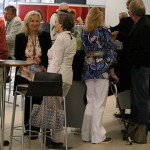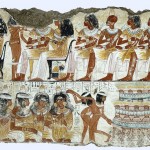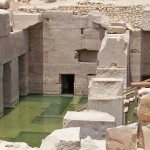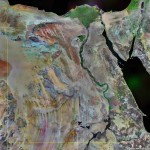
AWT Conference 2011 (Amarna) – Overview
The 2011 Ancient World Tours Conference was held at UCL, London over the weekend of 3rd and 4th September and focused on Amarna. The authors attended and offer this overview of the conference. Over the next ten days or so, we shall also be publishing detailed reviews of about half of the sessions in the Magazine section of Egyptological (and will formally become part of the next edition). [more…]
Libyan Desert Glass and the Breast Ornament of Tutankhamen
One of the many fabulous items in the jewellery collection from the tomb of Tutankhamen is a breast ornament. A highly decorative piece in the form of a winged scarab, dating to around 1330 BCE, it is currently on display in the Egyptian Museum in Cairo (JE 61884; Burton Photo No. P1133; Carter No. 267d). Adorned with silver, semi-precious stones and glass paste, all set into gold, the eye-catching centrepiece is a semi-translucent green scarab. Remarkable for its beauty, the pectoral has the added interest of scientific and archaeological mysteries that have yet to be completely unraveled. [more…]
Book Review: The Lost Tombs of Saqqara
Consisting of eight chapters, the main attraction of The Lost Tombs of Saqqara is the exceptional beauty of the photographs. For those unfamiliar with the site, Saqqara is a vast, sprawling necropolis to the south of Cairo. It was used from the Early Dynastic period onwards for royal and elite burials, and is best known for the Step Pyramid of Djoser, Egypt’s earliest pyramid, and its other Old Kingdom pyramids and beautifully decorated mastaba tombs. This book takes the reader into the New Kingdom area of Saqqara. [more…]
Book Review: History of Ancient Egypt: Neolithic Period ot the Early Dynastic Period including Menes, Narmer, Hieroglyphs, Thinis and More.
By Andrea Byrnes. Published on Egyptological, 9th September 2011 History of Ancient Egypt: Neolithic Period ot the Early Dynastic Period including Menes, Narmer, Hieroglyphs, Thinis and More. Edited by Grace Windsor ISBN 9-781241314675 This is a self-published book, one in a series about Ancient Egypt, widely available on online book stores. Before I […] [more…]

Egyptological Magazine – Edition 2
Welcome to the Second Edition of the Egyptological Magazine
In the Magazine we are pleased to see the return of two authors from the first edition. Brian Alm is continuing his popular series on the religion of the ancient Egyptians while Barbara O’Neill returns with another lavishly illustrated article. The image alongside, from the tomb of Nebamun is just one of the images in her article on the depiction of animal companions in tombs. We are delighted to welcome two new authors. Philip A. Femano has written a must-read article questioning the purpose of the blocking stones in the Ascending Passage of the Great Pyramid. Gary Beuk presents a biography of one of the best known early Egyptologists, and certainly the most colourful, Gionanni Battista Belzoni. Andrea Byrnes has added an article on the little known subject of Libyan Desert glass, a real treat for any Tutankhamun fans who have not heard of this unusual material found amongst his jewelery. We hope you will show your appreciation for all of our writers by leaving comments on their pieces. Our plan is for the Magazine to feature reviews as well as articles and you will find three of those as well, written by us. We attended the AWT conference last weekend and offer an overview and the first of our detailed reviews of invidual lectures. More will follow over the next few weeks. [more…]
Edition - July, 2011

Notes on the Osireion at Abydos
The Osireion was first excavated by Sir William Flinders Petrie, Margaret Murray and Petrie’s wife in the early 1900s. They found the tunnel and excavated towards what they called the “hypogeum.” It was full of sand and Roman filling when they began to clear it. Even before the full excavation of the site Murray speculated, convincingly, that “this was the building for the special worship of Osiris and the celebration of the Mysteries” [more…]

A few thoughts about duality and the desert
Brian Alm’s excellent introductory article on ancient Egyptian religion in Edition 1 of Egyptological, the first in a series of five articles on the topic, includes a section on duality. I have often pondered the extent to which the Egyptians segregated religious belief, which potentially formed an explanatory but idealized model of life, from everyday pragmatism. Duality is a good case in point. [more…]
Bloggers, Antiquities and Egypt’s Revolution
In the last week of March 2011 an UNESCO team visited Egypt to meet with the new Minister of Culture and try to understand the state of the country’s antiquities following widespread reports of vandalism, theft and looting. Egypt has seven World Heritage Sites: six cultural heritage sites and the fossilized mangroves of the Faiyum’s Whale Valley. [more…]

Television Review: Egypt’s Lost Cities
“Space Archaeology” is the new buzzword adopted by the BBC in its documentary “Egypt’s Lost Cities.” Not to be confused with the branch of archaeology studying orbiting space debris, it describes instead the use of satellite images to locate archaeological remains beneath the earth’s surface. [more…]
Pigs in Ancient Egypt – Photographs
Does anyone have any photographs of pigs in AE contexts that they would be willing for me to use? I want to write an article on the subject of how pigs were used in the Egyptian agricultural mix, and need photographs to illustrate the article which may appear online. You would need to own the […] [more…]
 By
By